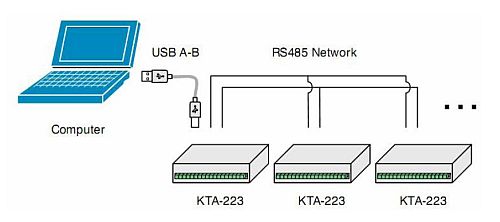USB IO Controller 8AI+8DO (8-28VDC)
Arduino-compatible controller with 8 SPDT relay outputs and 8 x 4-20mA or 0-5V or 0-3.3V analog inputs. USB and RS-485 serial interfaces. Windows, Mac OS X and Linux compatible.
The KTA-225 is a USB or RS485 controlled IO module for interfacing PCs to real world applications, such as controlling lights and sprinkler systems, reading sensors and monitoring switches or analog signals.
The Relays are capable of switching up to 5A at 250VAC, 10A at 120VAC and 10A at 24VDC but the PCB tracks will only handle up to about 5A. A simple ASCII protocol allows control from Windows/Mac/Linux using either USB Virtual COM drivers or RS485. Additionally, multiple devices can be connected to one RS485 bus, allowing control of many devices from one USB port.
The KTA-225 has relays with 5 VDC coils and requires an 8 to 28 VDC supply.
This controller is based on the hardware of the KTA-223 controller, but the number of analog inputs has been increased at the cost of the digital inputs. It can be programmed as a stand-alone controller using the free, open source Arduino environment. Internally, the controller is “shield compatible”, allowing the use of many extension boards designed for the Arduino Deumilanove.
As shipped the controller is loaded with a sketch or program that receives simple commands over the USB or RS485 serial port and switches relays or responds with the status of the analog inputs.
Multiple controllers can be connected to one or more PCs in an RS485 network. Each controller can be assigned an address and will respond to commands addressed to them.

An example program has been written and VB express 2010 to show you how to interface with the KTA-225 using a PC.
New in Version 3:
The newly revised KTA-225 have just arrived! As of mid December, we're shipping out version 3 of the KTA-225. It's fully compatible with the previous versions, but has a range of new features including:
- New relays with higher contact to coil isolation voltage for safer switching of loads
- Power, Tx and Rx LEDs Visible from the outside of the box
- Redesigned serial and USB circuitry and layout for higher baudrates, better reliability and better noise immunity
- Changes to the layout inside to match the changes made with the Arduino Uno
Web Interface Sketch:
Using the WebUi sketch and an Ethernet shield allows you to control the Relays and read the Analog Inputs from a web browser
WiFly Interface Sketch:
Check out this item news for a tutorial on using the WiFly shield to control the IO from a web browser
- Power Supply: 8 to 28VDC
- Current Consumption: 500mA
- 8 x Analog Inputs: 10 bit resolution, jumper selectable 0 to 5V, 0 to 3.3V or 0 to 20mA
- 8 x Relay Outputs: SPDT relays rated to 5A, 250VAC / 30VDC
- Protocol: Modbus ASCII protocol via USB Virtual Serial Port or RS485 Input
- Easily connect multiple units far apart by RS485
- Operating temperature: -20°C to 70°C
- Arduino Compatible
- Accepts Arduino Shields (Ethernet / XBee)
- Power Indicator LED
- Connections via Pluggable Screw Terminals
- All enclosed in Professional looking plastic case
- Dimensions: 140L x 110W x 30H (mm)
Documentation:
- Download Manual
- Download Schematic
- Download Arduino Sketch
- SoftI2cMaster Arduino Library by William Greiman (for use with SFC-010, requires SCL_PIN to be 13 and SDA_PIN to be 12)
- WebUi Sketch (requires Ethernet Shield)
- Wifi Interface Sketch (requires WiFly shield - tutorial available; see link above)
- Download RoHS Certificate
Software:
Faulty Goods and Warranty
Where such goods have been supplied we undertake to repair or replace them as quickly as possible.Prior to returning faulty items, please contact us with a description of the fault as one of our engineers might be able to assist you by resolving the issue over the phone.
A Warranty form must be filled out and returned with any goods.
Our standard warranty period is 12 months from the date of purchase unless stated otherwise.
Other warranty periods:
Labjack Products: 5 Years
Atop Products: 3 Years
MeanWell Products: 3 Years
Terracom Products: 3 Years
Warranty is subject to us being satisfied that a defect was caused by defective workmanship or materials and was not caused by or was not substantially contributed to by other factors beyond our control including incorrect installation, alterations or modifications of the product not recommended by the manufacturer.
Returns Policy
If you are dissatisfied with our goods you may return them within 14 days of the dispatch date. Contact us for an authorisation and we will refund your purchase less shipping costs and restocking fees. All returned goods MUST be in AS NEW condition including ALL PACKAGING and DOCUMENTATION / MANUALS etc.
Please note:
- The product returned will attract a 20% restocking fee.
- The customer must pay the delivery costs.
- Non standard, custom made or a specially manufactured or imported products are not returnable.
- Semiconductors, books and software are not refundable
Full Terms and Conditions
By placing an order with Ocean Controls, you agree to be bound by our Terms and Conditions of Trade.












